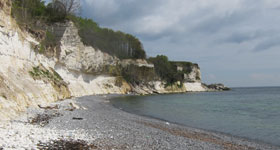Denmark is applying for inclusion of Stevns Klint on UNESCO's World Heritage List
None of the locations on UNESCO’s World Heritage List does show the consequences of the impact on the Earth of an asteroid that happened 65 million years ago – yet. Stevns Klint may though soon be included on the prestigious list, as the cliff presents an easily visible layer of black boundary clay that marks the extinction of more than half of the living species, including land-living dinosaurs, more clearly than many other locations.

Stevns Klint
Stenvs Klint has been the object of scientific research since the 18th century as one of the major stages in Earth’s history is extremely visible here. Stevns Klint is a 15 km long scenic coastal cliff with well exposed layers of Cretaceous chalk and Tertiary limestone that are very rich in fossils. A clearly visible thin layer of black boundary clay divides the soft chalk from the hard limestone marking the abrupt fall in primary production, thus clearly illustrating the Cretaceous-Tertiary boundary.
Stevns Klint has played a significant role in the international study of the causes of the mass extinction that happened 65 million years ago. The cliff was among the original study localities that first led scientists to the hypothesis of an asteroid impact as cause for the mass extinction.
The application to include Stevns Klint on UNESCO’s World Heritage List is the result of a broad cooperation between researchers, municipalities and public agencies with financial support from the Danish Agency of Culture, Geological Survey of Denmark and Greenland (GEUS), and Nordea Fonden. At UNESCO’s meeting this summer it will be decided whether the application concerning Stevns Klint will be selected to be one among the about 40 applications to be taken into consideration next year. The final decision is expected to be taken during summer 2013.
Finn Surlyk, Professor at the Department of Geography and Geology, has compiled the book that represents the core material of the application together with Tove Damholt, Director of Østsjællands Museum. The book is rich in pictures and illustrations, and describes the geological development of the cliff, its vegetation and wildlife, as well as local historical events. The book explains the role of Stevns Klint in past and current scientific research, how the cliff is conserved and protected, and why it is suitable for being included in the prestigious list.
If you have any questions about the book, you are welcome to contact Professor Finn Surlyk .
